Jie Zhang
Chongqing Jinshan Science & Technology
DCMIL: A Progressive Representation Learning Model of Whole Slide Images for Cancer Prognosis Analysis
Oct 16, 2025Abstract:The burgeoning discipline of computational pathology shows promise in harnessing whole slide images (WSIs) to quantify morphological heterogeneity and develop objective prognostic modes for human cancers. However, progress is impeded by the computational bottleneck of gigapixel-size inputs and the scarcity of dense manual annotations. Current methods often overlook fine-grained information across multi-magnification WSIs and variations in tumor microenvironments. Here, we propose an easy-to-hard progressive representation learning model, termed dual-curriculum contrastive multi-instance learning (DCMIL), to efficiently process WSIs for cancer prognosis. The model does not rely on dense annotations and enables the direct transformation of gigapixel-size WSIs into outcome predictions. Extensive experiments on twelve cancer types (5,954 patients, 12.54 million tiles) demonstrate that DCMIL outperforms standard WSI-based prognostic models. Additionally, DCMIL identifies fine-grained prognosis-salient regions, provides robust instance uncertainty estimation, and captures morphological differences between normal and tumor tissues, with the potential to generate new biological insights. All codes have been made publicly accessible at https://github.com/tuuuc/DCMIL.
OBJVanish: Physically Realizable Text-to-3D Adv. Generation of LiDAR-Invisible Objects
Oct 08, 2025Abstract:LiDAR-based 3D object detectors are fundamental to autonomous driving, where failing to detect objects poses severe safety risks. Developing effective 3D adversarial attacks is essential for thoroughly testing these detection systems and exposing their vulnerabilities before real-world deployment. However, existing adversarial attacks that add optimized perturbations to 3D points have two critical limitations: they rarely cause complete object disappearance and prove difficult to implement in physical environments. We introduce the text-to-3D adversarial generation method, a novel approach enabling physically realizable attacks that can generate 3D models of objects truly invisible to LiDAR detectors and be easily realized in the real world. Specifically, we present the first empirical study that systematically investigates the factors influencing detection vulnerability by manipulating the topology, connectivity, and intensity of individual pedestrian 3D models and combining pedestrians with multiple objects within the CARLA simulation environment. Building on the insights, we propose the physically-informed text-to-3D adversarial generation (Phy3DAdvGen) that systematically optimizes text prompts by iteratively refining verbs, objects, and poses to produce LiDAR-invisible pedestrians. To ensure physical realizability, we construct a comprehensive object pool containing 13 3D models of real objects and constrain Phy3DAdvGen to generate 3D objects based on combinations of objects in this set. Extensive experiments demonstrate that our approach can generate 3D pedestrians that evade six state-of-the-art (SOTA) LiDAR 3D detectors in both CARLA simulation and physical environments, thereby highlighting vulnerabilities in safety-critical applications.
Learning to Optimize Capacity Planning in Semiconductor Manufacturing
Sep 19, 2025Abstract:In manufacturing, capacity planning is the process of allocating production resources in accordance with variable demand. The current industry practice in semiconductor manufacturing typically applies heuristic rules to prioritize actions, such as future change lists that account for incoming machine and recipe dedications. However, while offering interpretability, heuristics cannot easily account for the complex interactions along the process flow that can gradually lead to the formation of bottlenecks. Here, we present a neural network-based model for capacity planning on the level of individual machines, trained using deep reinforcement learning. By representing the policy using a heterogeneous graph neural network, the model directly captures the diverse relationships among machines and processing steps, allowing for proactive decision-making. We describe several measures taken to achieve sufficient scalability to tackle the vast space of possible machine-level actions. Our evaluation results cover Intel's small-scale Minifab model and preliminary experiments using the popular SMT2020 testbed. In the largest tested scenario, our trained policy increases throughput and decreases cycle time by about 1.8% each.
DiEP: Adaptive Mixture-of-Experts Compression through Differentiable Expert Pruning
Sep 19, 2025Abstract:Despite the significant breakthrough of Mixture-of-Experts (MoE), the increasing scale of these MoE models presents huge memory and storage challenges. Existing MoE pruning methods, which involve reducing parameter size with a uniform sparsity across all layers, often lead to suboptimal outcomes and performance degradation due to varying expert redundancy in different MoE layers. To address this, we propose a non-uniform pruning strategy, dubbed \textbf{Di}fferentiable \textbf{E}xpert \textbf{P}runing (\textbf{DiEP}), which adaptively adjusts pruning rates at the layer level while jointly learning inter-layer importance, effectively capturing the varying redundancy across different MoE layers. By transforming the global discrete search space into a continuous one, our method handles exponentially growing non-uniform expert combinations, enabling adaptive gradient-based pruning. Extensive experiments on five advanced MoE models demonstrate the efficacy of our method across various NLP tasks. Notably, \textbf{DiEP} retains around 92\% of original performance on Mixtral 8$\times$7B with only half the experts, outperforming other pruning methods by up to 7.1\% on the challenging MMLU dataset.
A Multi-Scale Graph Neural Process with Cross-Drug Co-Attention for Drug-Drug Interactions Prediction
Sep 18, 2025



Abstract:Accurate prediction of drug-drug interactions (DDI) is crucial for medication safety and effective drug development. However, existing methods often struggle to capture structural information across different scales, from local functional groups to global molecular topology, and typically lack mechanisms to quantify prediction confidence. To address these limitations, we propose MPNP-DDI, a novel Multi-scale Graph Neural Process framework. The core of MPNP-DDI is a unique message-passing scheme that, by being iteratively applied, learns a hierarchy of graph representations at multiple scales. Crucially, a cross-drug co-attention mechanism then dynamically fuses these multi-scale representations to generate context-aware embeddings for interacting drug pairs, while an integrated neural process module provides principled uncertainty estimation. Extensive experiments demonstrate that MPNP-DDI significantly outperforms state-of-the-art baselines on benchmark datasets. By providing accurate, generalizable, and uncertainty-aware predictions built upon multi-scale structural features, MPNP-DDI represents a powerful computational tool for pharmacovigilance, polypharmacy risk assessment, and precision medicine.
SynBench: A Benchmark for Differentially Private Text Generation
Sep 18, 2025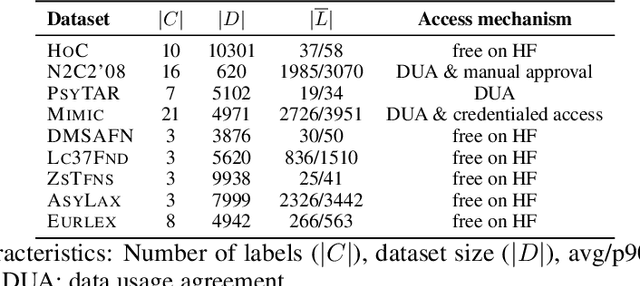
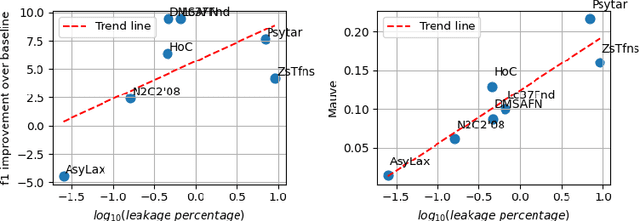

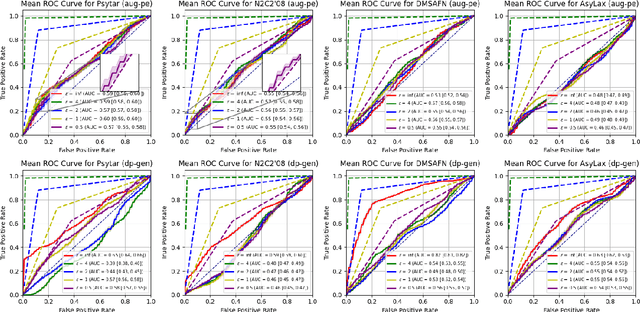
Abstract:Data-driven decision support in high-stakes domains like healthcare and finance faces significant barriers to data sharing due to regulatory, institutional, and privacy concerns. While recent generative AI models, such as large language models, have shown impressive performance in open-domain tasks, their adoption in sensitive environments remains limited by unpredictable behaviors and insufficient privacy-preserving datasets for benchmarking. Existing anonymization methods are often inadequate, especially for unstructured text, as redaction and masking can still allow re-identification. Differential Privacy (DP) offers a principled alternative, enabling the generation of synthetic data with formal privacy assurances. In this work, we address these challenges through three key contributions. First, we introduce a comprehensive evaluation framework with standardized utility and fidelity metrics, encompassing nine curated datasets that capture domain-specific complexities such as technical jargon, long-context dependencies, and specialized document structures. Second, we conduct a large-scale empirical study benchmarking state-of-the-art DP text generation methods and LLMs of varying sizes and different fine-tuning strategies, revealing that high-quality domain-specific synthetic data generation under DP constraints remains an unsolved challenge, with performance degrading as domain complexity increases. Third, we develop a membership inference attack (MIA) methodology tailored for synthetic text, providing first empirical evidence that the use of public datasets - potentially present in pre-training corpora - can invalidate claimed privacy guarantees. Our findings underscore the urgent need for rigorous privacy auditing and highlight persistent gaps between open-domain and specialist evaluations, informing responsible deployment of generative AI in privacy-sensitive, high-stakes settings.
Evaluating Cognitive-Behavioral Fixation via Multimodal User Viewing Patterns on Social Media
Sep 05, 2025Abstract:Digital social media platforms frequently contribute to cognitive-behavioral fixation, a phenomenon in which users exhibit sustained and repetitive engagement with narrow content domains. While cognitive-behavioral fixation has been extensively studied in psychology, methods for computationally detecting and evaluating such fixation remain underexplored. To address this gap, we propose a novel framework for assessing cognitive-behavioral fixation by analyzing users' multimodal social media engagement patterns. Specifically, we introduce a multimodal topic extraction module and a cognitive-behavioral fixation quantification module that collaboratively enable adaptive, hierarchical, and interpretable assessment of user behavior. Experiments on existing benchmarks and a newly curated multimodal dataset demonstrate the effectiveness of our approach, laying the groundwork for scalable computational analysis of cognitive fixation. All code in this project is publicly available for research purposes at https://github.com/Liskie/cognitive-fixation-evaluation.
Token Buncher: Shielding LLMs from Harmful Reinforcement Learning Fine-Tuning
Aug 28, 2025



Abstract:As large language models (LLMs) continue to grow in capability, so do the risks of harmful misuse through fine-tuning. While most prior studies assume that attackers rely on supervised fine-tuning (SFT) for such misuse, we systematically demonstrate that reinforcement learning (RL) enables adversaries to more effectively break safety alignment and facilitate advanced harmful task assistance, under matched computational budgets. To counter this emerging threat, we propose TokenBuncher, the first effective defense specifically targeting RL-based harmful fine-tuning. TokenBuncher suppresses the foundation on which RL relies: model response uncertainty. By constraining uncertainty, RL-based fine-tuning can no longer exploit distinct reward signals to drive the model toward harmful behaviors. We realize this defense through entropy-as-reward RL and a Token Noiser mechanism designed to prevent the escalation of expert-domain harmful capabilities. Extensive experiments across multiple models and RL algorithms show that TokenBuncher robustly mitigates harmful RL fine-tuning while preserving benign task utility and finetunability. Our results highlight that RL-based harmful fine-tuning poses a greater systemic risk than SFT, and that TokenBuncher provides an effective and general defense.
T2R-bench: A Benchmark for Generating Article-Level Reports from Real World Industrial Tables
Aug 27, 2025Abstract:Extensive research has been conducted to explore the capabilities of large language models (LLMs) in table reasoning. However, the essential task of transforming tables information into reports remains a significant challenge for industrial applications. This task is plagued by two critical issues: 1) the complexity and diversity of tables lead to suboptimal reasoning outcomes; and 2) existing table benchmarks lack the capacity to adequately assess the practical application of this task. To fill this gap, we propose the table-to-report task and construct a bilingual benchmark named T2R-bench, where the key information flow from the tables to the reports for this task. The benchmark comprises 457 industrial tables, all derived from real-world scenarios and encompassing 19 industry domains as well as 4 types of industrial tables. Furthermore, we propose an evaluation criteria to fairly measure the quality of report generation. The experiments on 25 widely-used LLMs reveal that even state-of-the-art models like Deepseek-R1 only achieves performance with 62.71 overall score, indicating that LLMs still have room for improvement on T2R-bench. Source code and data will be available after acceptance.
Mirroring Users: Towards Building Preference-aligned User Simulator with User Feedback in Recommendation
Aug 25, 2025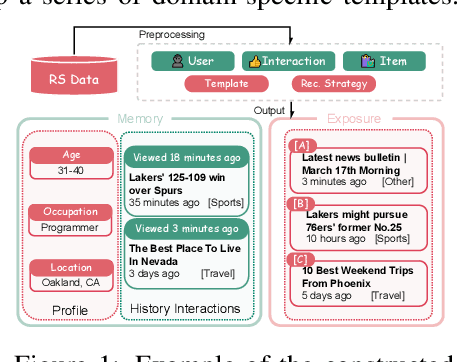
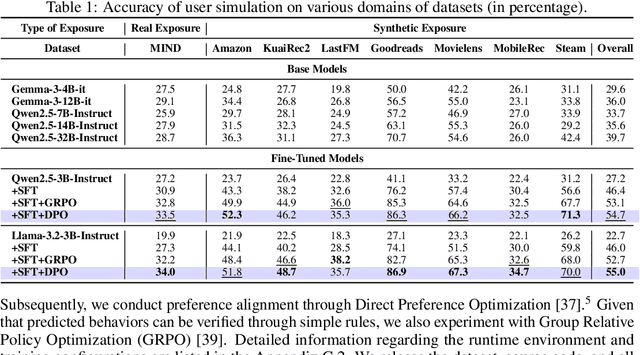
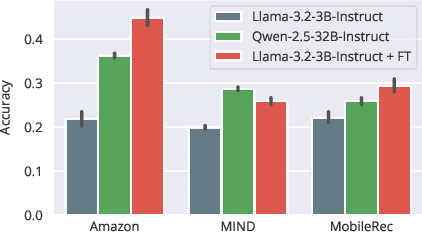
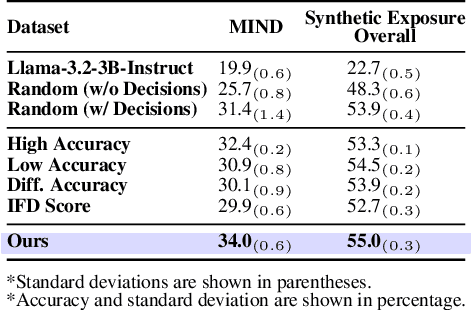
Abstract:User simulation is increasingly vital to develop and evaluate recommender systems (RSs). While Large Language Models (LLMs) offer promising avenues to simulate user behavior, they often struggle with the absence of specific domain alignment required for RSs and the efficiency demands of large-scale simulation. A vast yet underutilized resource for enhancing this alignment is the extensive user feedback inherent in RSs. However, directly leveraging such feedback presents two significant challenges. First, user feedback in RSs is often ambiguous and noisy, which negatively impacts effective preference alignment. Second, the massive volume of feedback largely hinders the efficiency of preference alignment, necessitating an efficient filtering mechanism to identify more informative samples. To overcome these hurdles, we introduce a novel data construction framework that leverages user feedback in RSs with advanced LLM capabilities to generate high-quality simulation data. Our framework unfolds in two key phases: (1) employing LLMs to generate cognitive decision-making processes on constructed simulation samples, reducing ambiguity in raw user feedback; (2) data distillation based on uncertainty estimation and behavior sampling to filter challenging yet denoised simulation samples. Accordingly, we fine-tune lightweight LLMs, as user simulators, using such high-quality dataset with corresponding decision-making processes. Extensive experiments verify that our framework significantly boosts the alignment with human preferences and in-domain reasoning capabilities of fine-tuned LLMs, and provides more insightful and interpretable signals when interacting with RSs. We believe our work will advance the RS community and offer valuable insights for broader human-centric AI research.
 Add to Chrome
Add to Chrome Add to Firefox
Add to Firefox Add to Edge
Add to Edge